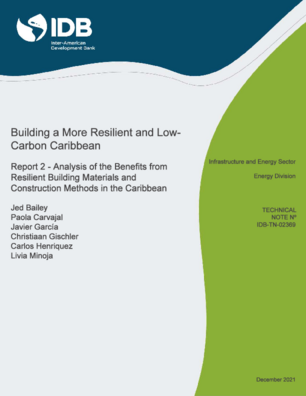Building a More Resilient and Low-Carbon Caribbean - Report 2: Analysis of the Benefits from Resilient Building Materials and Construction Methods in the Caribbean
Date
Dec 2021
The Caribbean islands are among the 25 most-vulnerable nations in terms of disasters per-capita or land area, and climate change is only expected to intensify these vulnerabilities. The loss caused by climate events drags the ability of the Caribbean countries to invest in infrastructure and social programs, contributing to slower productivity growth, poorer health outcomes, and lower standards of living.
Within this context, building resiliency should become a priority for the Caribbean countries. The series “Building a more resilient and low-carbon Caribbean”, focuses on improving the resiliency, sustainability and decarbonization of the construction industry in the Caribbean.
The first report presented a quantification of the economic losses caused by climate impact events in the Caribbean Region and correlate these figures with the most common construction materials, typically used in each of the countries building typologies.
Report 2 - Analysis of the benefits from resilient building materials and construction methods in the Caribbean, demonstrates that using resilient materials and construction methods in the Caribbean is economically beneficial across a wide range of building types and construction options. These economic benefits stem from the reduced hazard loss from using more resilient materials and construction methods, as well as from reduced energy use and CO2 emissions from improving the buildings insulation and using greener building material options. These benefits are therefore most notable in areas with high risk from climate impacts, high energy prices, and high CO2 content in the electricity mix.
Within this context, building resiliency should become a priority for the Caribbean countries. The series “Building a more resilient and low-carbon Caribbean”, focuses on improving the resiliency, sustainability and decarbonization of the construction industry in the Caribbean.
The first report presented a quantification of the economic losses caused by climate impact events in the Caribbean Region and correlate these figures with the most common construction materials, typically used in each of the countries building typologies.
Report 2 - Analysis of the benefits from resilient building materials and construction methods in the Caribbean, demonstrates that using resilient materials and construction methods in the Caribbean is economically beneficial across a wide range of building types and construction options. These economic benefits stem from the reduced hazard loss from using more resilient materials and construction methods, as well as from reduced energy use and CO2 emissions from improving the buildings insulation and using greener building material options. These benefits are therefore most notable in areas with high risk from climate impacts, high energy prices, and high CO2 content in the electricity mix.




